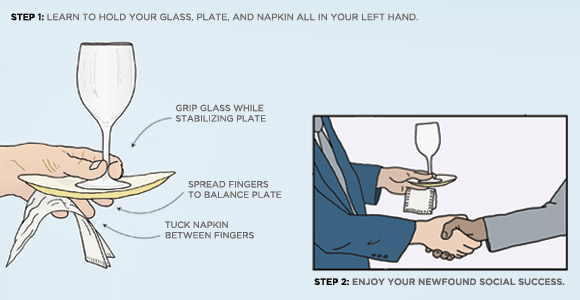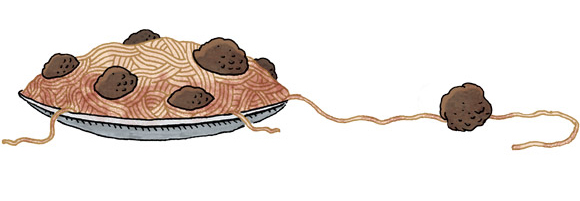
Eye on the Quads
Peas and Queues
At the Etiquette Dinner, students learn an important lesson: give up.
by Carrie Golus, AB’91, AM’93 | Illustration by Matthew Elliott
The Etiquette Dinner begins with a friend-of-a-friend horror story.
Once, says etiquette expert Jill Bremer, a job candidate flew to Chicago for an important interview. She was picked up at the airport and taken to an Italian restaurant—but, to her discomfiture, the menus never arrived. Spaghetti and meatballs had already been ordered for the table.
The candidate was not offered the job. It was “a road warrior position” requiring a lot of client entertaining, Bremer explains, and she had failed the company’s spaghetti-and-meatballs test.
A wave of mortified laughter spreads through the Quad Club dining room. “If you think dining etiquette doesn’t matter,” Bremer says, “think again.”
The annual Etiquette Dinner, now in its fifth year, is easily the most popular of the weekly workshops that Chicago Careers in Business (CCIB) students must attend. The students enjoy a formal meal as Bremer guides them through it, showing slides at the front of the room and occasionally circulating to correct students’ technique.
“We could just tell the students how to hold a plate at a buffet,” says CCIB director Keith Dipple. (Later in her lecture, Bremer reveals the art of balancing a plate, a napkin, and a wine glass in just one hand, leaving the other free for shaking.) “But unless they actually do it, it doesn’t go in.”
Setting the table is a case in point. When the students arrived for dinner, the plates, glasses, and silverware were stacked in the center of each table. Some students made their best effort; others waited for instructions. As Bremer explains which utensils go where and why—“The blade of the knife faces you,” she says, “because in the Middle Ages, if it faced your neighbor, you were essentially challenging him to a duel”—the room is filled with the clinking of silverware and glasses being repositioned. The place setting includes red wine glasses, but they contain cold tea; the dinner guests are third-years and not old enough to drink.
The bread arrives, and Bremer explains how to pass it: to the right. If you want to cheat at bread passing, however—if there is a particularly luscious roll you must have—take the bread basket, offer it to the person on your left, then pass to the right, “which puts you second in line,” Bremer says. The rolls in the basket are identical; nevertheless a number of students practice cheating.
Next topic: hunger. “When you’re out for a business meal, you don’t necessarily have to clean your plate,” Bremer says. “Don’t communicate that you are the starving college student you truly are.”
As for awkward foods, Bremer advises, simply avoid them. A cherry tomato in a salad “is a disaster in the making,” she says. “It’s going to fly.” When ordering at a business meal, she advises, select a dish that’s simple to eat with a knife and fork. “No club sandwiches. Nothing that needs a bib.” The students laugh uproariously at that visual.
The salad appears: mesclun, already dressed, with a cherry tomato, mercifully cut in half. “Much better than my own cooking,” one student observes.
The need for training in basic dining skills—at one point, Bremer shows the group how to use a knife properly—is not unique to UChicago, stereotypes aside. Harvard, Northwestern, Columbia, and Reed, among others, also hold etiquette dinners for students. The decline of the family dinner is one reason, says Dipple: “When I was growing up in London in the ’60s and ’70s, mealtime was a social event, the one time my mother insisted on us all being there. That seems to have passed.” Colleges have also become more diverse; some international students, as well as some Asian American students, he says, may have grown up with chopsticks and never eaten a formal dinner with Western utensils.
As the salad plates are cleared away, Bremer demystifies the tricky food of her cautionary tale. For long noodles like spaghetti, she says, there are two choices: take a couple of strands and twist them against the inner rim of the plate, or cut the noodles with the side of a fork.
The entrée arrives. Coiled next to the chicken and broccoli, like a nest of venomous snakes, is spaghetti in a thin buttery sauce. When twisted against the rim of the plate, the noodles slide away; when picked up with a fork, they slither back to the table. Bremer’s advice to those in difficulty: “Give up,” she says. “Give up, and never order it again.”

